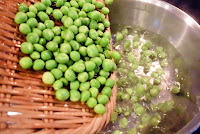
Whole recipe (solids):
117 calories; 8.5 g protein; 0.5 g fat; 19.1 g carbohydrate; 9.7 g net carbs; 31 mg sodium (with usukuchi soy sauce); 0 mg cholesterol; 9.4 g fiber
<Ingredients>
For ohitashi marinade
200 cc dashi
1 tsp sake
1 tsp mirin
1/3 tsp usukuchi soy sauce
<Directions>
1.
Make ohitashi marinade.
Microwave sake and mirin to boil (5+ seconds).
Add sake, mirin and usukuchi soy sauce to dashi, and mix.
If dashi is hot, cool.
Ohitashi marinade is ready.
2.
Shell English peas.
3.
Bring (500+ cc ) water to boil, and cook peas for 4-5 minutes.
4.
Drain peas, and immediately put in ohitashi marinade.
(If ohitashi marinade is hotter than room temperature, chill the container in ice water for immediate cooling before refrigerating.)
(Immediately after soaking, pea surface is wrinkled as in above photo, but it becomes smooth as in photo at left after 1 hour or so.)
<Notes>
- Keeps in the fridge for several days.
- Photo at right shows an example of the color effect of endomame no hisui-bitashi (topping for hijiki no itameni).
- Usukuchi soy sauce has paler color and tastes saltier than regular soy sauce. If not available, use regular soy sauce (slightly less than specified amount above) and a tiny pinch of salt.
- Above nutrition figures are based on an assumption that 15% of ohitashi marinade is consumed with peas.
- Hisui literally means jade. When used for dishes, it implies light green color (of skin).
- Instead of soaking cooked English peas in flavored dashi as above, peas can be directly simmered in flavored dashi and immediately chilled for color retention. If this method is used, the dish would be called "hisuini [lit. jade (color) simmered]."











No comments:
Post a Comment